Answered step by step
Verified Expert Solution
Question
1 Approved Answer
1. Which parts or recommendations that were mentioned within organizations do you think should have been changed prior to COVID-19 that were identified? 2. How
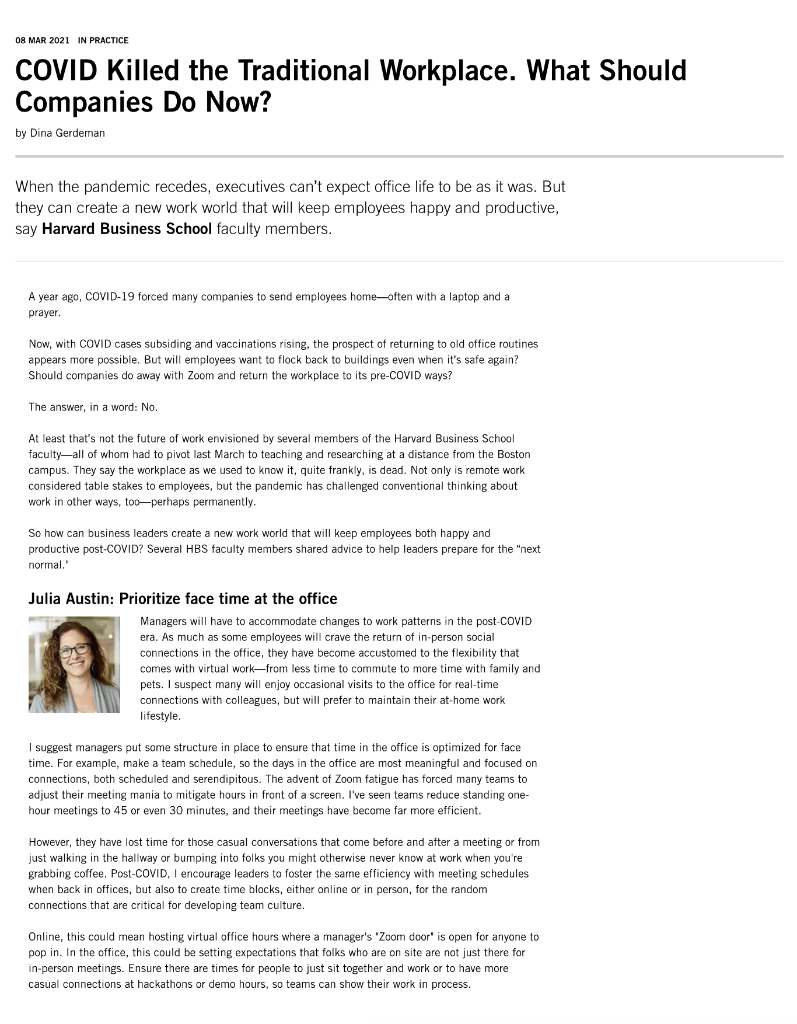
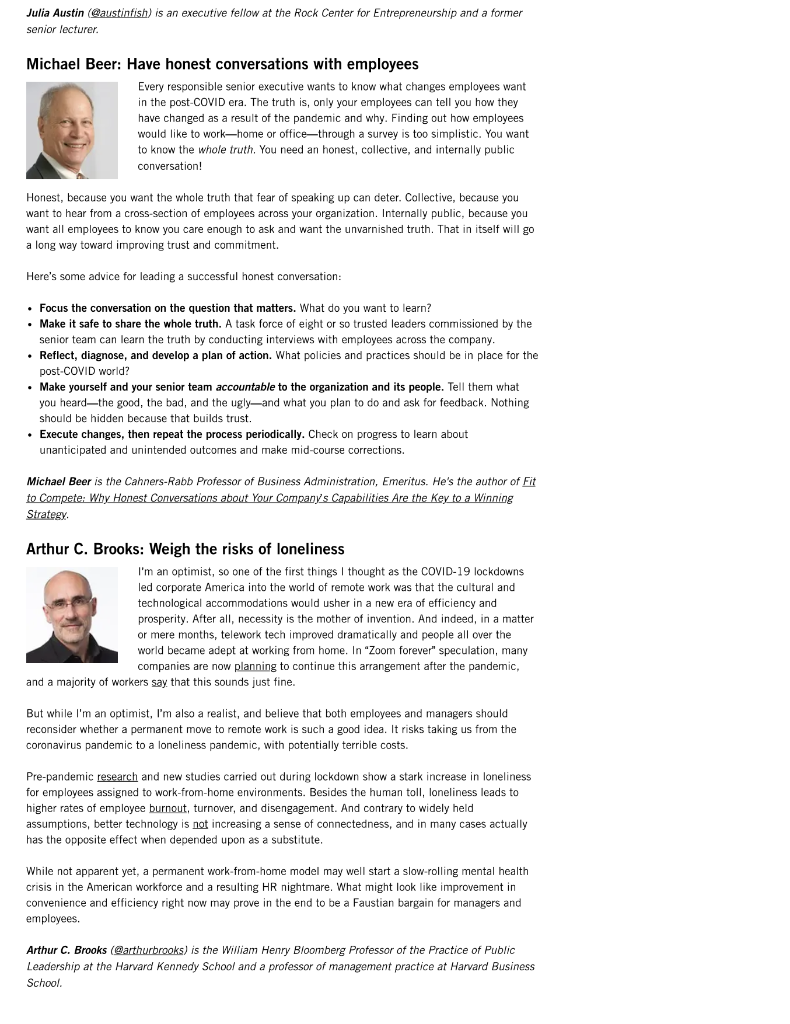
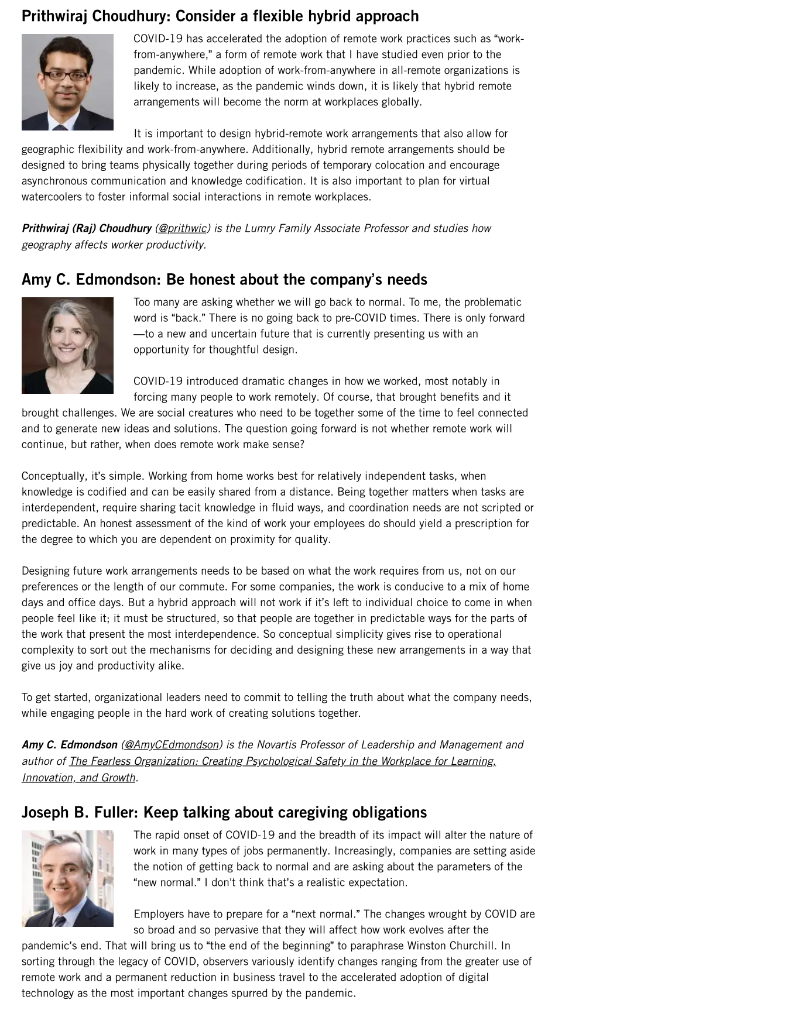
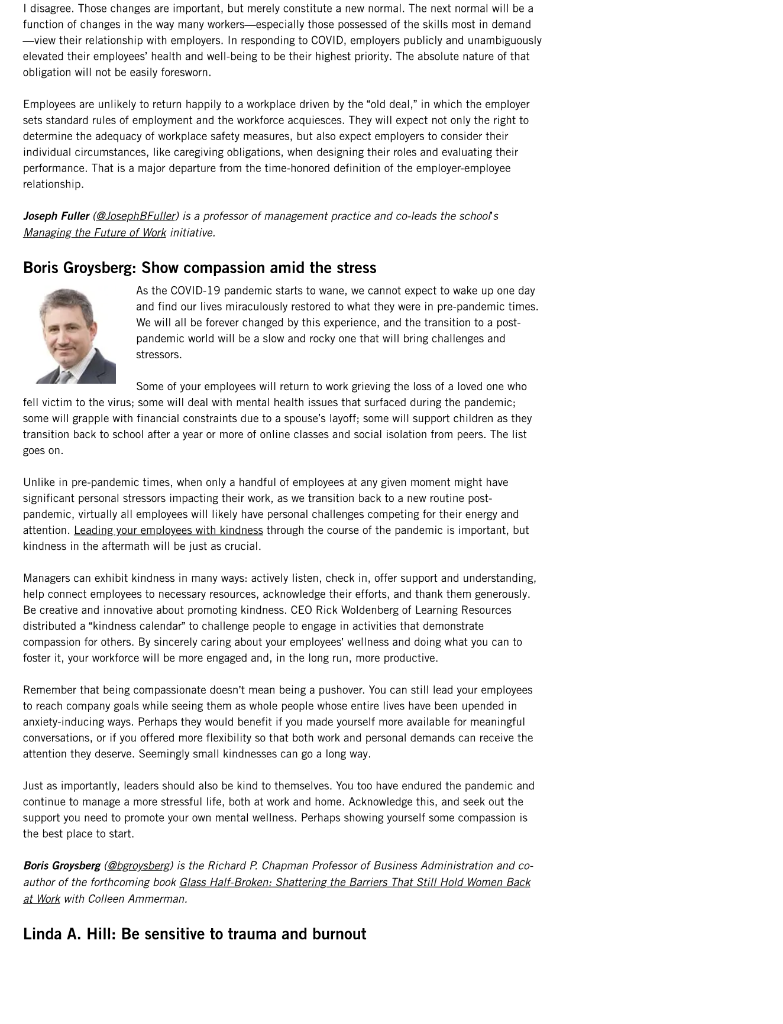
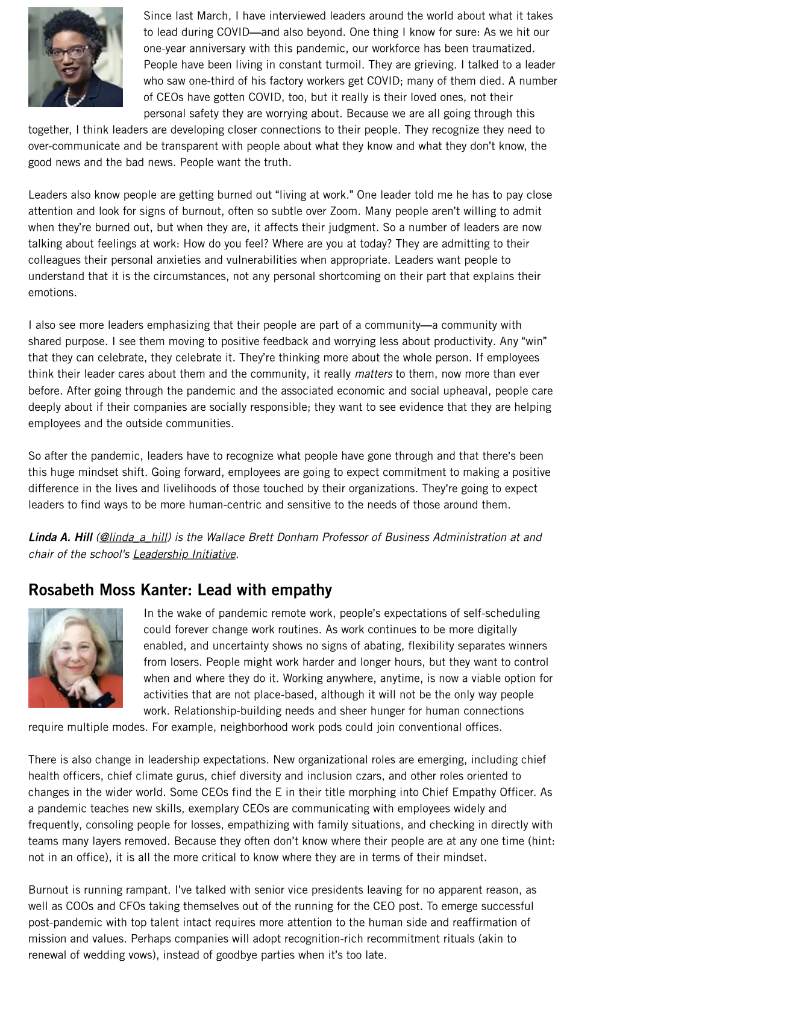
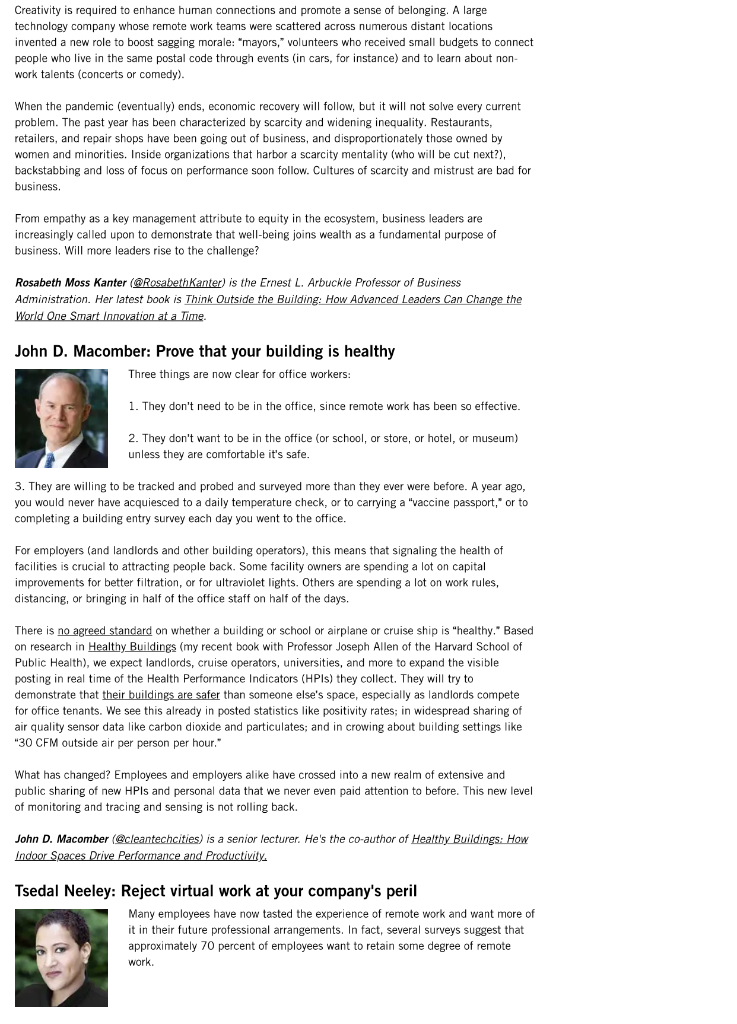


1. Which parts or recommendations that were mentioned within organizations do you think should have been changed prior to COVID-19 that were identified?
2. How can the changes you mentioned best be sustained for the health of organizations?
3. What approach to feedback and planning is most likely to make a lasting improvement within organizations?
4. What type of support do feel managers needed to guide them through this process?
O8 MAR 2021 IN PRACTICE COVID Killed the Traditional Workplace. What Should Companies Do Now? by Dina Gerdeman When the pandemic recedes, executives can't expect office life to be as it was. But they can create a new work world that will keep employees happy and productive, say Harvard Business School faculty members. A year ago, COVID-19 forced many companies to send employees home-often with a laptop and a prayer. Now, with COVID cases subsiding and vaccinations rising, the prospect of returning to old office routines appears more possible. But will employees want to flock back to buildings even when it's safe again? Should companies do away with Zoom and return the workplace to its pre-COVID ways? The answer, in a word: No. At least that's not the future of work envisioned by several members of the Harvard Business School faculty-all of whom had to pivot last March to teaching and researching at a distance from the Boston campus. They say the workplace as we used to know it, quite frankly, is dead. Not only is remote work considered table stakes to employees, but the pandemic has challenged conventional thinking about work in other ways, too-perhaps permanently. So how can business leaders create a new work world that will keep employees both happy and productive post-COVID? Several HBS faculty members shared advice to help leaders prepare for the "next normal." Julia Austin: Prioritize face time at the office Managers will have to accommodate changes to work patterns in the post-COVID era. As much as some employees will crave the return of in-person social connections in the office, they have become accustomed to the flexibility that comes with virtual work-from less time to commute to more time with family and pets. I suspect many will enjoy occasional visits to the office for real-time connections with colleagues, but will prefer to maintain their at-home work lifestyle. I suggest managers put some structure in place to ensure that time in the office is optimized for face time. For example, make a team schedule, so the days in the office are most meaningful and focused on connections, both scheduled and serendipitous. The advent of Zoom fatigue has forced many teams to adjust their meeting mania to mitigate hours in front of a screen. I've seen teams reduce standing onehour meetings to 45 or even 30 minutes, and their meetings have become far more efficient. However, they have lost time for those casual conversations that come before and after a meeting or from just walking in the hallway or bumping into folks you might otherwise never know at work when you're grabbing coffee. Post-COVID, I encourage leaders to foster the same efficiency with meeting schedules when back in offices, but also to create time blocks, either online or in person, for the random connections that are critical for developing team culture. Julia Austin (Qaustinfish) is an executive fellow at the Rock Center for Entrepreneurship and a former senior lecturer. Michael Beer: Have honest conversations with employees Every responsible senior executive wants to know what changes employees want in the post-COVID era. The truth is, only your employees can tell you how they have changed as a result of the pandemic and why. Finding out how employees would like to work-home or office-through a survey is too simplistic. You want to know the whole truth. You need an honest, collective, and internally public conversation! Honest, because you want the whole truth that fear of speaking up can deter. Collective, because you want to hear from a cross-section of employees across your organization. Internally public, because you want all employees to know you care enough to ask and want the unvarnished truth. That in itself will go a long way toward improving trust and commitment. Here's some advice for leading a successful honest conversation: - Focus the conversation on the question that matters. What do you want to learn? - Make it safe to share the whole truth. A task force of eight or so trusted leaders commissioned by the senior team can learn the truth by conducting interviews with employees across the company. - Reflect, diagnose, and develop a plan of action. What policies and practices should be in place for the post-COVID world? - Make yourself and your senior team accountable to the organization and its people. Tell them what you heard_the good, the bad, and the ugly-and what you plan to do and ask for feedback. Nothing should be hidden because that builds trust. - Execute changes, then repeat the process periodically. Check on progress to learn about unanticipated and unintended outcomes and make mid-course corrections. Michael Beer is the Cahners-Rabb Professor of Business Administration. Emeritus. He's the author of Fit to Compete: Why Honest Conversations about Your Companys Capabilities Are the Key to a Winning Strategy. Arthur C. Brooks: Weigh the risks of loneliness I'm an optimist, so one of the first things I thought as the COVID-19 lockdowns led corporate America into the world of remote work was that the cultural and technological accommodations would usher in a new era of efficiency and prosperity. After all, necessity is the mother of invention. And indeed, in a matter or mere months, telework tech improved dramatically and people all over the world became adept at working from home. In "Zoom forever" speculation, many companies are now planning to continue this arrangement after the pandemic, and a majority of workers say that this sounds just fine. But while I'm an optimist, l'm also a realist, and believe that both employees and managers should reconsider whether a permanent move to remote work is such a good idea. It risks taking us from the coronavirus pandemic to a loneliness pandemic, with potentially terrible costs. Pre-pandemic research and new studies carried out during lockdown show a stark increase in loneliness for employees assigned to work-from-home environments. Besides the human toll, loneliness leads to higher rates of employee burnout, turnover, and disengagement. And contrary to widely held assumptions, better technology is not increasing a sense of connectedness, and in many cases actually has the opposite effect when depended upon as a substitute. While not apparent yet, a permanent work-from-home model may well start a slow-rolling mental health crisis in the American workforce and a resulting HR nightmare. What might look like improvement in convenience and efficiency right now may prove in the end to be a Faustian bargain for managers and employees. Arthur C. Brooks (arthurbrooks) is the William Henry Bloomberg Professor of the Practice of Public Leadership at the Harvard Kennedy School and a professor of management practice at Harvard Business School. Prithwiraj Choudhury: Consider a flexible hybrid approach COVID-19 has accelerated the adoption of remote work practices such as "workfrom-anywhere," a form of remote work that I have studied even prior to the pandemic. While adoption of work-from-anywhere in all-remote organizations is likely to increase, as the pandemic winds down, it is likely that hybrid remote arrangements will become the norm at workplaces globally. It is important to design hybrid-remote work arrangements that also allow for geographic flexibility and work-from-anywhere. Additionally, hybrid remote arrangements should be designed to bring teams physically together during periods of temporary colocation and encourage asynchronous communication and knowledge codification. It is also important to plan for virtual watercoolers to foster informal social interactions in remote workplaces. Prithwiraj (Raj) Choudhury (@prithwic) is the Lumry Family Associate Professor and studies how geography affects worker productivity. Amy C. Edmondson: Be honest about the company's needs Too many are asking whether we will go back to normal. To me, the problematic word is "back." There is no going back to pre-COVID times. There is only forward -to a new and uncertain future that is currently presenting us with an opportunity for thoughtful design. COVID-19 introduced dramatic changes in how we worked, most notably in forcing many people to work remotely. Of course, that brought benefits and it brought challenges. We are social creatures who need to be together some of the time to feel connected and to generate new ideas and solutions. The question going forward is not whether remote work will continue, but rather, when does remote work make sense? Conceptually, it's simple. Working from home works best for relatively independent tasks, when knowledge is codified and can be easily shared from a distance. Being together matters when tasks are interdependent, require sharing tacit knowledge in fluid ways, and coordination needs are not scripted or predictable. An honest assessment of the kind of work your employees do should yield a prescription for the degree to which you are dependent on proximity for quality. Designing future work arrangements needs to be based on what the work requires from us, not on our preferences or the length of our commute. For some companies, the work is conducive to a mix of home days and office days. But a hybrid approach will not work if it's left to individual choice to come in when people feel like it; it must be structured, so that people are together in predictable ways for the parts of the work that present the most interdependence. So conceptual simplicity gives rise to operational complexity to sort out the mechanisms for deciding and designing these new arrangements in a way that give us joy and productivity alike. To get started, organizational leaders need to commit to telling the truth about what the company needs, while engaging people in the hard work of creating solutions together. Amy C. Edmondson (AmyCEdmondson) is the Novartis Professor of Leadershio and Management and author of The Fearless Organization: Creatiog Psychological Safety in the Workplace for Learniog. innovation, and Growth. Joseph B. Fuller: Keep talking about caregiving obligations The rapid onset of COVID-19 and the breadth of its impact will alter the nature of work in many types of jobs permanently. Increasingly, companies are setting aside the notion of getting back to normal and are asking about the parameters of the "new normal." I don't think that's a realistic expectation. Employers have to prepare for a "next normal." The changes wrought by COVID are so broad and so pervasive that they will affect how work evolves after the pandemic's end. That will bring us to "the end of the beginning" to paraphrase Winston Churchill. In sorting through the legacy of COVID, observers variously identify changes ranging from the greater use of remote work and a permanent reduction in business travel to the accelerated adoption of digital technology as the most important changes spurred by the pandemic. I disagree. Those changes are important, but merely constitute a new normal. The next normal will be a function of changes in the way many workers-especially those possessed of the skills most in demand -view their relationship with employers. In responding to COVID, employers publicly and unambiguously elevated their employees' health and well-being to be their highest priority. The absolute nature of that obligation will not be easily foresworn. Employees are unlikely to return happily to a workplace driven by the "old deal," in which the employer sets standard rules of employment and the workforce acquiesces. They will expect not only the right to determine the adequacy of workplace safety measures, but also expect employers to consider their individual circumstances, like caregiving obligations, when designing their roles and evaluating their performance. That is a major departure from the time-honored definition of the employer-employee relationship. Joseph Fuller (@@osephBFuller) is a professor of management practice and co-leads the schoois Managing the Future of Work initiative. Boris Groysberg: Show compassion amid the stress As the COVID-19 pandemic starts to wane, we cannot expect to wake up one day and find our lives miraculously restored to what they were in pre-pandemic times. We will all be forever changed by this experience, and the transition to a postpandemic world will be a slow and rocky one that will bring challenges and stressors. Some of your employees will return to work grieving the loss of a loved one who fell victim to the virus; some will deal with mental health issues that surfaced during the pandemic; some will grapple with financial constraints due to a spouse's layoff; some will support children as they transition back to school after a year or more of online classes and social isolation from peers. The list goes on. Unlike in pre-pandemic times, when only a handful of employees at any given moment might have significant personal stressors impacting their work, as we transition back to a new routine postpandemic, virtually all employees will likely have personal challenges competing for their energy and attention. Leading your employees with kindness through the course of the pandemic is important, but kindness in the aftermath will be just as crucial. Managers can exhibit kindness in many ways: actively listen, check in, offer support and understanding. help connect employees to necessary resources, acknowledge their efforts, and thank them generously. Be creative and innovative about promoting kindness. CEO Rick Woldenberg of Learning Resources distributed a "kindness calendar" to challenge people to engage in activities that demonstrate compassion for others. By sincerely caring about your employees' wellness and doing what you can to foster it, your workforce will be more engaged and, in the long run, more productive. Remember that being compassionate doesn't mean being a pushover. You can still lead your employees to reach company goals while seeing them as whole people whose entire lives have been upended in anxiety-inducing ways. Perhaps they would benefit if you made yourself more available for meaningful conversations, or if you offered more flexibility so that both work and personal demands can receive the attention they deserve. Seemingly small kindnesses can go a long way. Just as importantly, leaders should also be kind to themselves. You too have endured the pandemic and continue to manage a more stressful life, both at work and home. Acknowledge this, and seek out the support you need to promote your own mental wellness. Perhaps showing yourself some compassion is the best place to start. Boris Groysberg (Qogroysberg) is the Richard P. Chapman Professor of Business Administration and coauthor of the forthcoming book Glass Half-Broken: Shattering the Barriers That Still Hold Women Back at Work with Colleen Ammerman. Linda A. Hill: Be sensitive to trauma and burnout Since last March, I have interviewed leaders around the world about what it takes to lead during COVID-and also beyond. One thing I know for sure: As we hit our one-year anniversary with this pandemic, our workforce has been traumatized. People have been living in constant turmoil. They are grieving. I talked to a leader who saw one-third of his factory workers get COVID; many of them died. A number of CEOs have gotten COVID, too, but it really is their loved ones, not their personal safety they are worrying about. Because we are all going through this together, I think leaders are developing closer connections to their people. They recognize they need to over-communicate and be transparent with people about what they know and what they don't know, the good news and the bad news. People want the truth. Leaders also know people are getting burned out "living at work." One leader told me he has to pay close attention and look for signs of burnout, often so subtle over Zoom. Many people aren't willing to admit when they're burned out, but when they are, it affects their judgment. So a number of leaders are now talking about feelings at work: How do you feel? Where are you at today? They are admitting to their colleagues their personal anxieties and vulnerabilities when appropriate. Leaders want people to understand that it is the circumstances, not any personal shortcoming on their part that explains their emotions. I also see more leaders emphasizing that their people are part of a community-a community with shared purpose. I see them moving to positive feedback and worrying less about productivity. Any "win" that they can celebrate, they celebrate it. They're thinking more about the whole person. If employees think their leader cares about them and the community, it really matters to them, now more than ever before. After going through the pandemic and the associated economic and social upheaval, people care deeply about if their companies are socially responsible; they want to see evidence that they are helping employees and the outside communities. So after the pandemic, leaders have to recognize what people have gone through and that there's been this huge mindset shift. Going forward, employees are going to expect commitment to making a positive difference in the lives and livelihoods of those touched by their organizations. They're going to expect leaders to find ways to be more human-centric and sensitive to the needs of those around them. Linda A. Hill (Qlinda_a hill) is the Wallace Brett Donham Professor of Business Administration at and chair of the school's Leadership Initiative. Rosabeth Moss Kanter: Lead with empathy In the wake of pandemic remote work, people's expectations of self-scheduling could forever change work routines. As work continues to be more digitally enabled, and uncertainty shows no signs of abating, flexibility separates winners from losers. People might work harder and longer hours, but they want to control when and where they do it. Working anywhere, anytime, is now a viable option for activities that are not place-based, although it will not be the only way people work. Relationship-building needs and sheer hunger for human connections require multiple modes. For example, neighborhood work pods could join conventional offices. There is also change in leadership expectations. New organizational roles are emerging, including chief health officers, chief climate gurus, chief diversity and inclusion czars, and other roles oriented to changes in the wider world. Some CEOs find the E in their title morphing into Chief Empathy Officer. As a pandemic teaches new skills, exemplary CEOs are communicating with employees widely and frequently, consoling people for losses, empathizing with family situations, and checking in directly with teams many layers removed. Because they often don't know where their people are at any one time (hint: not in an office), it is all the more critical to know where they are in terms of their mindset. Creativity is required to enhance human connections and promote a sense of belonging. A large technology company whose remote work teams were scattered across numerous distant locations invented a new role to boost sagging morale: "mayors," volunteers who received small budgets to connect people who live in the same postal code through events (in cars, for instance) and to learn about nonwork talents (concerts or comedy). When the pandemic (eventually) ends, economic recovery will follow, but it will not solve every current problem. The past year has been characterized by scarcity and widening inequality. Restaurants, retailers, and repair shops have been going out of business, and disproportionately those owned by women and minorities. Inside organizations that harbor a scarcity mentality (who will be cut next?), backstabbing and loss of focus on performance soon follow. Cultures of scarcity and mistrust are bad for business. From empathy as a key management attribute to equity in the ecosystem, business leaders are increasingly called upon to demonstrate that well-being joins wealth as a fundamental purpose of business. Will more leaders rise to the challenge? Rosabeth Moss Kanter (QRosabethKanter) is the Ernest L. Arbuckie Professor of Business Administration. Her latest book is Think Outside the Building: How Advanced Leaders Can Change the World One Smart lnnovation at a Time. John D. Macomber: Prove that your building is healthy Three things are now clear for office workers: 1. They don't need to be in the office, since remote work has been so effective. 2. They don't want to be in the office (or school, or store, or hotel, or museum) unless they are comfortable it's safe. 3. They are willing to be tracked and probed and surveyed more than they ever were before. A year ago, you would never have acquiesced to a daily temperature check, or to carrying a "vaccine passport," or to completing a building entry survey each day you went to the office. For employers (and landlords and other building operators), this means that signaling the health of facilities is crucial to attracting people back. Some facility owners are spending a lot on capital improvements for better filtration, or for ultraviolet lights. Others are spending a lot on work rules, distancing, or bringing in half of the office staff on half of the days. There is no agreed standard on whether a building or school or airplane or cruise ship is "healthy." Based on research in Healthy Buildings (my recent book with Professor Joseph Allen of the Harvard School of Public Health), we expect landlords, cruise operators, universities, and more to expand the visible posting in real time of the Health Performance Indicators (HPIs) they collect. They will try to demonstrate that their buildings are safer than someone else's space, especially as landlords compete for office tenants. We see this already in posted statistics like positivity rates; in widespread sharing of air quality sensor data like carbon dioxide and particulates; and in crowing about building settings like "30 CFM outside air per person per hour." What has changed? Employees and employers alike have crossed into a new realm of extensive and public sharing of new HPls and personal data that we never even paid attention to before. This new level of monitoring and tracing and sensing is not rolling back. John D. Macomber (@cleantechcities) is a senior lecturer. He's the co-author of Healthy Buildings: How Indoor Spaces Drive Performance and Productivity. Tsedal Neeley: Reject virtual work at your company's peril Many employees have now tasted the experience of remote work and want more of it in their future professional arrangements. In fact, several surveys suggest that approximately 70 percent of employees want to retain some degree of remote work. While many organizations are working toward a hybrid model that includes a mix of remote and in-person work, some employers want their employees back in the office once the pandemic ends. For example, David Solomon at Goldman Sachs called remote work an "aberration" and rejects it as a legitimate format that can have permanence. This is a tension that companies have to resolve. The virtualization of work is here. The virtualization of careers is here. Without reconciling this tension, the risk will be losing excellent talent who are looking for flexibility from their employers. There are many companies that are currently thinking deeply about the future of their workforce. They have to produce clear policies when the COVID-19 threat diminishes precipitously. A related issue that I am hearing about from companies is centered on how to think about real estate holdings because a hybrid model will have implications on how much physical space needs to be established for a fluid workforce. Another set of companies like Dropbox have cast themselves as "virtual-first" organizations. They are saying to employees, "It's your choice whether to come in or not. And you are free to move somewhere else-just as long as you do the work we want you to do." Ultimately, every company will have to determine the best path for their employees and their entire ecosystem. Likewise, every company needs to be prepared to handle the cultural impact of whatever path they follow. Tsedal Neeley (Qtsedal) is the Naylor Fitzhugh Professor of Business Administration and author of the upcoming book Remote Work Revolustion: Succeeding from Anywhere. Gary P. Pisano: Make work inspiring-at the office or not Pre-COVID, we commonly used the phrase "going to the office" to mean a physical act-quite literally getting in your car or taking public transportation to a place called the office. If you went away, you put an "away from the office" message on your email. The past year has changed how we define the office. It's no longer specifically a physical place. The office now means a state of working. Post-COVID, I think we are going to accept that the office is not necessarily a physical space, but a state of working. This does not mean we won't go to those places we call the office or "work." Everyone has different constraints, needs, situations, and jobs. If you have little children at home, for instance, or live in a place without a good workspace, etc., the physical place called the office can be critical. Or, you may have certain tasks where your physical presence matters. Good working relationships and trust get built over those coffees and lunches. We can't replace those. But I do hope we can be more flexible about how we ask people to work and find a better balance. The idea that you must be physically present to be productive is just not valid. Leaders should be focused on how to make work inspiring, compelling, and engaging, whether that work is done at the office or not. Gary P. Pisano (@motagp61) is the Harry E. Figgie, Jr. Professor of Business Administration and the Senior Associate Dean for Faculty Development. Raffaella Sadun: Be fair when deciding who works remotely The shift to work-from-home is much more than a change in where people work. It is as much a change in how we work, and therefore how work is managed. The change is profound and pertains to what we do (reallocating commuting time to other activities, personal or work-related), and how we do it (meeting virtually, using other forms of communication, fragmenting our activities, being distracted, or in some cases focusing more). Given the time we have spent with this mode of work now, and the stunning adjustment we have made, I suspect that we will not immediately bounce back to a pre-COVID rhythm and way of managing people, even when it's safe to do so. In my view, the hardest challenge that companies face is how to manage the fact that work from home means different things to different people. It is possible that some people have loved to work independently, whereas others have felt starved of the social interactions that an office provides. Additionally, the loss of the office is different for independent workers versus managers, who need to find ways to coordinate and motivate people now that they cannot casually pop in at a desk. As a consequence, I expect that the desire to go back to "normal" will vary not just across companies, but also across employees within the same company. This is problematic. It is much easier to manage extreme solutions (all in the office or all remote) rather than a hybrid situation, precisely because the way in which people are motivated, coordinated, and monitored are so different in these modalities. As a manager, I would think hard about this problem right now. Who will want to come back? Who will want to stay at home? And how am I going to make sure there is fairness and effectiveness across groups? Perhaps managers will need to step in to impose some sort of Solomonic compromise: Some days of the week may become mandatory in the office for all, to avoid the need to manage any possibly conflicting views. Over time, if differences in opinion are not managed well, it is also possible that mixed feelings about remote work among employees may result in greater turnover. All that said, I think this is a case where one-size-fits-all solutions unfortunately do not exist; different conditions may call for different approaches. A practical piece of advice is thus to be proactive and elicit workers' preferences and explore different approaches now. The return to the office may not be as simple as we imagined at the beginning of the pandemic. Raffaella Sadun (@raffasadun) is a professor of business administration and among the founders of the World Management Survey and the Executive Time Use Study. About the Author Dina Gerdeman is a senior writer at Harvard Business School Working Knowledge. [Image: iStockphoto/blackred] What will your post-COVID work experience look like? Share your insights belowStep by Step Solution
There are 3 Steps involved in it
Step: 1

Get Instant Access to Expert-Tailored Solutions
See step-by-step solutions with expert insights and AI powered tools for academic success
Step: 2

Step: 3

Ace Your Homework with AI
Get the answers you need in no time with our AI-driven, step-by-step assistance
Get Started


